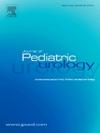Shehata technique versus Fowler-Stephens orchidopexy in intra-abdominal testis: A meta-analysis
IF 2
3区 医学
Q2 PEDIATRICS
引用次数: 0
Abstract
Introduction
The management of intra-abdominal testis (IAT) represents a significant clinical challenge, necessitating the transposition of the testis from the abdominal cavity to the scrotum. This procedure is rendered complex by the abbreviated length of the testicular vessels.
Objective
Our purpose in this study was to conduct a systematic review and meta-analysis comparing Shehata technique (ST) versus Fowler Stephens technique (FST) in treating patients with IAT.
Study design
We conducted a comprehensive literature search using several databases, including Ovid Medline, Cochrane, PubMed, Google Scholar, Web of Sciences, EMBASE, and SCOPUS until February 2024. This study included research that compared ST and FST for managing intra-abdominal testis. We evaluated the rates of atrophy and retraction, as well as the overall success rates, for both techniques.
Results
Six studies were identified as appropriate for meta-analysis, comparing orchidopexy performed using the ST with 169 patients, against the FST involving 162 patients. The comparison showed no statistically significant age difference at the time of surgery between the groups (I2 = 0%) (WMD 0.05, 95% CI − 1.24 to 1.34; p = 0.94). Operative time in first the stage was lower in the FST group than ST group (I2 = 95%) (WMD 10.90, 95% CI 1.94 to 19.87; p = 0.02). Operative time in the second stage was lower in the ST group than FST group (I2 = 83%) (WMD - 6.15, 95% CI - 12.21 to −0.10; p = 0.05). Our analysis showed that ST had a similar atrophy rate (I2 = 0%) (OR: 0.45, 95% CI: 0.20 to 1.01; p = 0.05). No difference was found between techniques in terms of retraction rate (I2 = 0%) (OR: 0.64, 95% CI: 0.17 to 2.47; p = 0.52). The ST demonstrated a notably higher overall success rate compared to FST (I2 = 1%) (RR: 1.14, 95% CI: 1.03 to 1.27; p = 0.009). Overall success rate in ST and FST were 87% and 74%, respectively. Overall atrophy rate in ST and FST were 5% and 12%, respectively. Overall retraction rate in ST and FST were 5% and 10%, respectively.
Discussion
The ST, renowned for its pioneering two-stage laparoscopic approach that leverages mechanical traction to lengthen the testicular vessels, is gaining popularity due to its recognized safety and efficacy. Conversely, the Fowler-Stephens technique, a traditional method that relies on collateral blood supply for testicular mobilization, has come under examination for its potential link to an increased risk of testicular atrophy.
Conclusion
This meta-analysis reveals that the Shehata technique has similar or better outcomes compared to the Fowler-Stephens technique in IAT management. Further prospective multicentric randomized controlled trials are warranted.
Summary Table. Summary of findings.
| Study (Author et al.) | Testis (n) | ST/FST | ||||
|---|---|---|---|---|---|---|
| Empty Cell | ST | FST | Total | Atrophy (n) | Retraction (n) | Overall success (n) |
| Liu et al. [14] | 22 | 23 | 45 | 0/1 | 0/4 | 22/18 |
| Dawood et al. [15] | 20 | 21 | 41 | 0/3 | 1/1 | 14/13 |
| Bawazir et al. [16] | 11 | 18 | 29 | 0/3 | 2/2 | 9/8 |
| Alekrashy et al. [17] | 20 | 18 | 38 | 0/2 | NR | 18/15 |
| Bidault-Jourdainne et al. [18] | 80 | 67 | 147 | 8/9 | NR | 68/54 |
| An Ye et al. [19] | 16 | 15 | 31 | 0/2 | 0/1 | 16/12 |
腹腔内睾丸切除术中 Shehata 技术与 Fowler-Stephens 睪丸固定术的比较:一项荟萃分析
导言腹腔内睾丸(IAT)的治疗是一项重大的临床挑战,必须将睾丸从腹腔移位到阴囊。本研究旨在对 Shehata 技术(ST)和 Fowler Stephens 技术(FST)治疗 IAT 患者的效果进行系统回顾和荟萃分析。研究设计我们使用多个数据库进行了全面的文献检索,包括 Ovid Medline、Cochrane、PubMed、Google Scholar、Web of Sciences、EMBASE 和 SCOPUS,直至 2024 年 2 月。本研究包括比较 ST 和 FST 管理腹腔内睾丸的研究。我们评估了两种技术的萎缩率和回缩率以及总体成功率。结果有六项研究被确定为适合进行荟萃分析,比较了 169 名患者使用 ST 和 162 名患者使用 FST 进行的睾丸切除术。比较结果显示,两组患者手术时的年龄差异无统计学意义(I2 = 0%)(WMD 0.05,95% CI - 1.24 至 1.34;P = 0.94)。FST 组第一阶段的手术时间低于 ST 组(I2 = 95%)(WMD 10.90,95% CI 1.94 至 19.87;P = 0.02)。ST 组第二阶段的手术时间低于 FST 组(I2 = 83%)(WMD - 6.15,95% CI - 12.21 至 -0.10;P = 0.05)。我们的分析表明,ST 具有相似的萎缩率(I2 = 0%)(OR:0.45,95% CI:0.20 至 1.01;P = 0.05)。在回缩率(I2 = 0%)方面,不同技术之间没有差异(OR:0.64,95% CI:0.17 至 2.47;P = 0.52)。与 FST 相比,ST 的总体成功率明显更高(I2 = 1%)(RR:1.14,95% CI:1.03 至 1.27;P = 0.009)。ST 和 FST 的总体成功率分别为 87% 和 74%。ST和FST的总体萎缩率分别为5%和12%。ST和FST的总体回缩率分别为5%和10%。 讨论ST因其开创性的两阶段腹腔镜方法而闻名,该方法利用机械牵引延长睾丸血管,因其公认的安全性和有效性而越来越受欢迎。相反,Fowler-Stephens 技术是一种依靠侧支血液供应来动员睾丸的传统方法,因其与睾丸萎缩风险增加的潜在联系而备受关注。 结论这项荟萃分析表明,在 IAT 管理中,Shehata 技术与 Fowler-Stephens 技术相比具有相似或更好的效果。有必要进一步开展前瞻性多中心随机对照试验。研究(作者等)睾丸(n)ST/FSTE空洞细胞STFST总萎缩(n)回缩(n)总体成功率(n)Liu等[14]2223450/10/422/18Dawood等[15]2021410/10/422/18Dawood等[16]2021410/10/422/18[15]2021410/31/114/13Bawazir等[16]1118290/32/29/8Alekrashy等[17]2018380/2NR18/15Bidault-Jourdainne等[18]80671478/9NR68/54安晔等[19]1615310/20/116/12
本文章由计算机程序翻译,如有差异,请以英文原文为准。
求助全文
约1分钟内获得全文
求助全文
来源期刊

Journal of Pediatric Urology
PEDIATRICS-UROLOGY & NEPHROLOGY
CiteScore
3.70
自引率
15.00%
发文量
330
审稿时长
4-8 weeks
期刊介绍:
The Journal of Pediatric Urology publishes submitted research and clinical articles relating to Pediatric Urology which have been accepted after adequate peer review.
It publishes regular articles that have been submitted after invitation, that cover the curriculum of Pediatric Urology, and enable trainee surgeons to attain theoretical competence of the sub-specialty.
It publishes regular reviews of pediatric urological articles appearing in other journals.
It publishes invited review articles by recognised experts on modern or controversial aspects of the sub-specialty.
It enables any affiliated society to advertise society events or information in the journal without charge and will publish abstracts of papers to be read at society meetings.
 求助内容:
求助内容: 应助结果提醒方式:
应助结果提醒方式:


